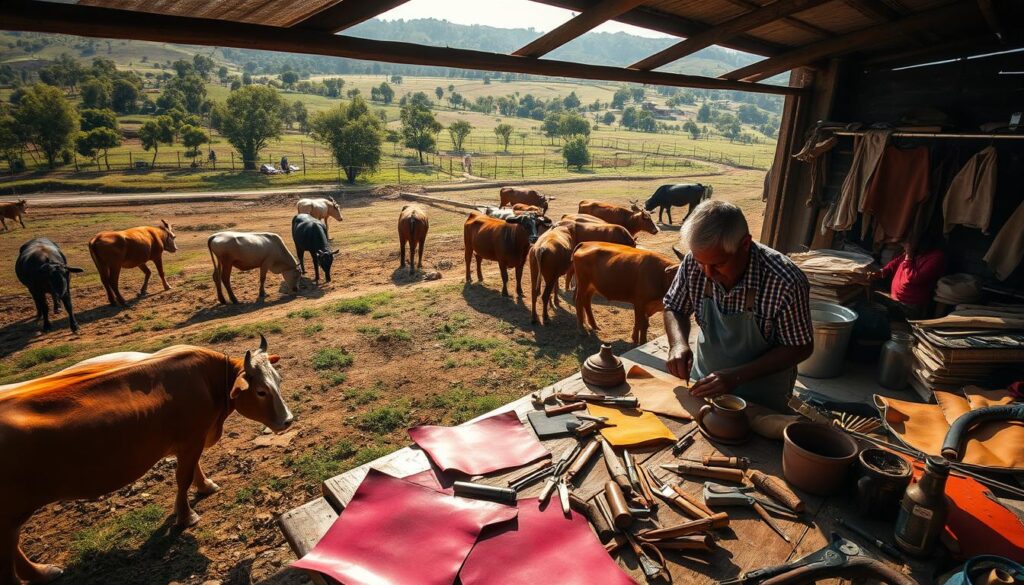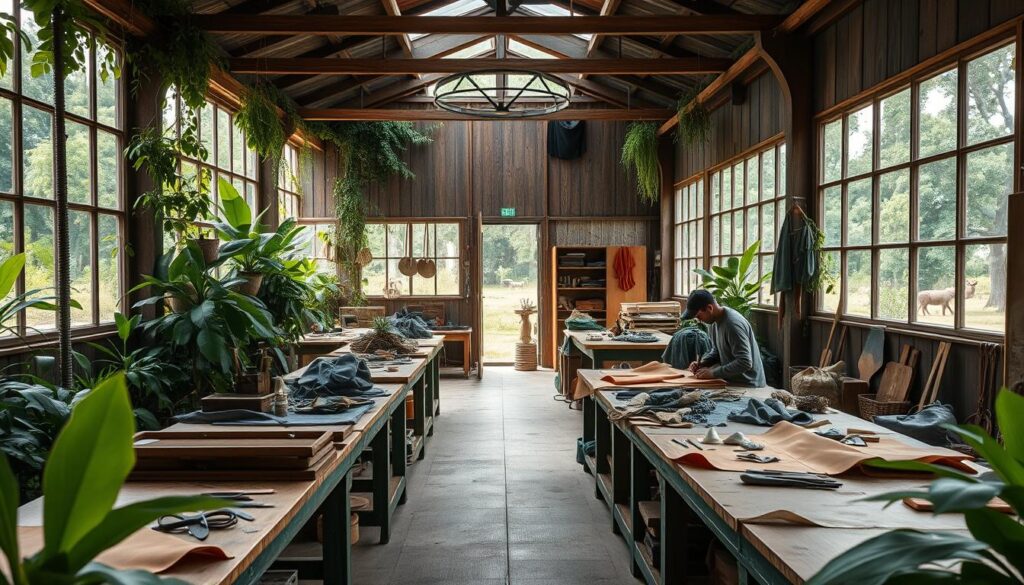I’ve seen a big problem in fashion: people get confused about leather and its look-alikes. This confusion makes it hard for shoppers to choose wisely. It’s annoying when you can’t spot real leather from fake, right? But don’t worry, I’m here to help.
In this guide, I’ll explain everything about leather trading in fashion. We’ll look at the leather supply chain, from finding raw materials to selling them. We’ll also talk about how big this industry is and its economic impact.
Key Takeaways
- Leather trading is a complex process in the fashion industry
- The leather supply chain spans from raw material to retail
- Genuine leather has distinct characteristics from imitations
- Sustainability is a growing concern in leather production
- The leather industry has a significant economic impact
- Ethical considerations play a role in leather sourcing
- Fashion trends influence leather demand and production
Understanding the Leather Industry’s Role in Fashion
I’ve seen the leather industry change a lot over time. It has moved from old tanning ways to new, green methods. This change in leather fashion is amazing.
The evolution of leather in fashion
Leather has always been key in fashion. But now, we’re seeing a move towards better, greener choices. Big names are leading this change.
Puma SE introduced Xetic sneakers with new leather. Nike also made vegan leather SB Dunk sneakers. These are part of their Zero Waste plan.
Key players in the leather supply chain
The leather supply chain is complex. It goes from getting raw materials to selling them. Tanneries are very important, using chromium in most tanning.
Designers and brands also play a big role. They set trends and shape what people want to buy.
Economic impact of leather trading
Leather trading has a big economic effect. The leather goods market is growing fast, about 7% each year. In 2021, real leather made up more than half the market.
But synthetic leather is catching up. It’s expected to grow even faster, at 7.5% this decade.
| Segment | Market Share (2021) | Growth Rate (CAGR) |
|---|---|---|
| Genuine Leather | Over 50% | ~7% |
| Synthetic Leather | Less than 50% | 7.5% |
The leather industry is worth about $212 billion. It’s expected to grow by 6.6% by 2030. This shows leather products are still in demand, even with new options.
Leather Sourcing: From Farm to Fashion
I’ve explored the world of leather sourcing. It’s a complex journey from farm to fashion. The process begins with cattle ranching, which affects the environment a lot.
In fact, up to 80% of deforestation in the Amazon Rainforest is caused by cattle ranching. This is for both food and fashion.
The land needed for leather production is huge. In Brazil, it takes about 10,000 square meters to make nine leather jackets. This means one acre is needed for 10 leather bags or 17 pairs of boots.

The leather supply chain goes through many countries, making it hard to track. Despite this, there’s a growing demand for accountability. This is important because cow skin leather is very harmful to the environment.
Some brands are looking for sustainable alternatives. They source leather from local Ethiopian providers. They use traditional handcrafting to lessen environmental harm.
| Traditional Leather Sourcing | Sustainable Leather Sourcing |
|---|---|
| High deforestation rates | Local, sustainable providers |
| Complex, untraceable supply chains | Transparent, local supply chains |
| High environmental impact | Reduced environmental footprint |
| Limited community benefits | Supports local communities |
As people learn more, the fashion industry is changing. It’s moving towards more sustainable and ethical leather sourcing. This is a tough journey, but it’s essential for the future of fashion and our planet.
The Leather Supply Chain: A Complex Network
The leather supply chain is a complex system. It goes from farms to fashion houses. Understanding this network helps us see the industry’s challenges and chances.
Raw Material Procurement
Leather starts with raw materials, mainly from cattle. Sadly, this has caused a lot of deforestation. In the Amazon, 800 million trees were lost in just six years, partly because of leather demand.
Tanning Process
The tanning process is key in making leather. It uses a lot of water and harmful chemicals. This worries about worker safety and the environment. Many tanneries are small or medium-sized, making rules hard to follow.
Leather Distribution
Distribution covers many areas, from wholesale to retail. Brands are now looking at sustainable sources. For example, Puma wants to use only deforestation-free bovine leather by 2030. Other companies have similar goals, with 70-100% of their leather from certified sources.
| Brand | Sustainable Leather Target | Target Year |
|---|---|---|
| Puma | 100% deforestation-free | 2030 |
| Adidas | 100% LWG-certified | 2025 |
| M&S | 90% LWG-certified | 2023 |
The industry is moving towards sustainability. The Deforestation-Free Call to Action for Leather aims to change the supply chain by 2030. This effort pushes for transparency, traceability, and teamwork among brands to make the leather industry better.
Sustainable Leather: Balancing Fashion and Environment
I’ve been looking into sustainable leather and it’s tough. The fashion world really hurts the planet. It’s responsible for about 10% of global carbon emissions and 20% of global wastewater. That’s a big problem!
New, eco-friendly leather options are coming up. Plant-based leather, like Banofi Leather made from crop waste, is a good example. It has 90% lower carbon emissions than animal leather. This is great news for those who care about the planet.

But, there’s a catch. Making these leathers last long and break down easily is hard. They’re better for the planet, but not perfect. Also, making sustainable clothes costs more because of fair labor and materials.
Let’s look at some shocking stats:
| Metric | Value |
|---|---|
| Annual textile waste | 92 million tonnes |
| Clothing disposed per US consumer | 82 pounds annually |
| Water needed for one cotton t-shirt | Up to 2,700 liters |
These numbers show we really need to change how we make leather and clothes. Even with challenges, new companies are working towards a greener future in fashion.
Ethical Considerations in Leather Production
I’ve been looking into ethical leather production, and it’s shocking. The leather industry has big problems with animal welfare, tannery conditions, and the environment.
Animal Welfare Concerns
Cattle for leather often get treated badly. They face harm without pain relief and are sometimes killed while still alive. Despite living over 20 years, many are killed young. This is a big worry for animal welfare in the leather world.
Working Conditions in Tanneries
Tannery jobs are also a big problem. Workers are at risk from harmful chemicals. Sadly, 90% of leather is made with cancer-causing stuff like chromium and formaldehyde. This makes tannery workers 50% more likely to get pancreatic cancer.
Social Impact on Farming Communities
The leather industry’s effects go beyond tanneries. There’s forced labor and exploitation in Brazil, Paraguay, and Vietnam. Slaughterhouse workers often have mental health problems, like PTSD, from killing animals.
| Ethical Concern | Impact |
|---|---|
| Animal Welfare | Mutilation, premature slaughter |
| Tannery Conditions | 50% higher cancer risk |
| Social Impact | Forced labor, mental health issues |
These issues show we need to change the leather industry fast. As buyers, we should ask for clearer information and better practices in leather making.
Leather Trading in the Fashion Industry: Market Trends and Challenges
I’ve been watching the leather market closely. The fashion world is facing some big challenges. Sustainability is now a top priority in the leather trade.
The leather goods market is expected to reach $304.80 billion in 2024. This is a huge number. But what’s even more exciting is the growth rate. We’re looking at a CAGR of 4.30%, reaching $376.21 billion by 2029.
This growth is not just about numbers. It’s driving innovation in eco-friendly tanning. It’s also pushing the development of leather alternatives.
Big names like Kering SA and Hermès International S.A. are making big moves. They’re expanding their product lines and launching new items to attract high-end customers. Synthetic leather is also gaining popularity fast. It’s expected to grow at a whopping 7.5% due to rising full-grain leather costs and increased awareness of animal welfare issues.
Asia-Pacific is the market to watch. It’s the fastest-growing region for leather goods. Meanwhile, Europe holds the largest market share in 2024. The competition is fierce, with a mix of major players and smaller companies vying for market share.
As consumers become more aware of environmental and social impacts, the demand for sustainable and ethical options is skyrocketing. This is forcing the industry to adapt and innovate. I’m excited to see how these fashion industry challenges will shape the future of leather trading.
Luxury Leather Goods: The High-End Market
The luxury leather goods market has grown a lot. In 2023, it was worth $75.78 billion. It’s expected to hit $99.95 billion by 2031. This shows more people want high-quality, fancy items.
Designer Brands and Leather Craftsmanship
Big names like LVMH, Hermès, and Chanel lead this market. Their success comes from top-notch leather work. For instance, S.T. Dupont works with 17 trades to make special finishes.
Pricing Strategies for Luxury Leather Items
Pricing in this market shows off brand value and skill. As people have more money, they’re willing to spend more on fancy items. What the brand stands for and its status really matter to buyers.
Consumer Demographics for High-End Leather Products
This market is for wealthy folks who value quality and status. Men’s luxury leather goods, like wallets and briefcases, are for men. Young tech lovers and business folks like cool designs, like the Défi briefcase with tablet and phone slots.
| Market Segment | Key Features | Popular Products |
|---|---|---|
| Men’s Luxury Leather | Elegance, Durability | Wallets, Briefcases |
| Women’s Luxury Leather | Fashion-forward, Exclusive | Handbags, Accessories |
| Tech-Oriented | Innovative, Functional | Tablet Cases, Phone Holders |
Global Leather Exports and Imports: Key Statistics
I’ve been exploring the global leather trade, and the numbers are amazing! China is the biggest leather importer, with $1.6 billion in 2023. Italy and Vietnam follow closely, with imports of $1.3 billion and $1.2 billion. Leather exports and imports are crucial in the fashion world.
The market for apparel and leather products is growing fast. In 2023, it’s worth $1045.45 billion. It’s expected to reach $1127.96 billion by 2024, a 7.9% increase. By 2028, it could hit $1511.52 billion. The Asia-Pacific region and Western Europe are leading this growth.
Footwear is a big part of leather imports. The US saw a 31.4% increase in footwear imports in September 2021. This reached $27.2 billion, $6.5 billion more than in 2020. The market includes everything from raw leather to finished products.
The world of leather exports and imports is always changing. Countries like France, Indonesia, and Spain import hundreds of millions of dollars worth of leather. As we move forward, finding a balance between economic growth and sustainability will be important.
